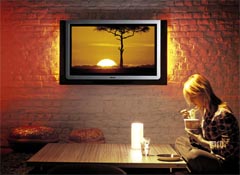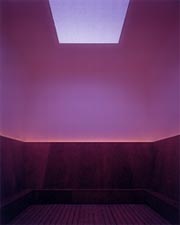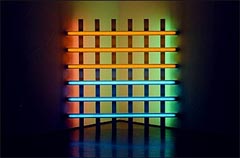Paul Boutin's Slate article on my tired.com project was picked up by Digg today, even though it was written two years ago.

Thank you Paul and Digg!
Paul Boutin's Slate article on my tired.com project was picked up by Digg today, even though it was written two years ago.

Thank you Paul and Digg!
In this light, it's not surprising that the products of so many design programs (RCA, ITP and Interaction Ivrea) can be read equally as art and as technology and why the mixture on We Make Money Not Art has proven to be so popular. We can even trace the lineages: dodgeball.com is closely linked to flash mobs, which are a modern version of a 60s Happening. Flickr.com was created out of Game Neverending, which was as much a conceptual art piece as a game. There's almost certainly a relationship between Philips Ambilight TVs James Turrell's lighted color spaces, Dan Flavin's work and color field painting, too. (this leads to all kinds of interesting questions about intellectual property)



(Philips, Turrell, Flavin)
There's a lot of feedback between these worlds when the participants rub shoulders and explore each others' ideas: technologists can borrow ideas from artists and vice-versa. Jeff Bezos, the founders of Google, and countless other dotcom entrepreneurs used to go to Burning Man for more than the opportunity to wear funny outfits and dance all night long (though that kind of freedom is immensely valuable, too). Partly it was a generational thing--every generation's entertainment influences its view of the world, and the rave generation is no different--but it was a way to explore the idea of art, technology and experience without the normal intellectual shackles. The core that drives Google to not want to be evil and iRobot to include a geek port on the Roomba.is the same core that drives people to make technology into art. It's the ability to see beyond the technology to what it does for/to people and for/to the world. It's the core user-centered design philosophy.
Also, critically, the Bay Area technology art scene has always been part of the counterculture. With no government or academic support, tech art in the Bay flourished for close to 40 years with few in any official capacity noticing. This gives it a unique flavor that's not just the expected (and certainly existent) hippie dilettante vibe that seems to be people's expectation. Tapping the Beats and Dada more than the hippies and Surrealism, SRL embodies depths of nihilism that can shock jaded New Yorkers. Ant Farm fetishized plastic, television and the Kennedy assassination.
The Bay Area is also home to an enormous amount of technology innovation and a major center of contemporary industrial design innovation. IDEO, which looms much larger in the industry than even their sizable portfolio of projects, and frogdesign, have their primary bases of operation in the Bay. I think it's no accident that the proximity of technology, art, subversive culture and optimism produces some of the best and most innovative products in the world.
This is, of course, not to say that all innovation happens in the Bay Area or that these things only exist in the Bay, but I believe that the mix is uniquely influential there. Other cities trying to create similar environments and design organizations thinking about what makes for good design should look toward the history of the Bay Area as a venue for subversive technology art, rather than just looking at the concentration of money on Sand Hill Road (though that's certainly important, too).
*=Yes, I realize that the art world is subject to economic pressures, too. In fact, I believe that the art world is a large, under-regulated market driven by huge amounts of insider trading and influence peddling, but my rant on the mythology of art as pure expression and the failure of art schools to teach students that it's a commercial practice will have to wait for another day. For now, there's this post that addresses some of the issues. My point in the above description is that it's not nearly as bound as client-driven design or market-driven development.
[Addendum: Liz points out that San Franciscan exceptionalism seems to have creeped into this post. That's probably true. I like San Francisco a lot and think it's special. I also acknowledge that despite its specialness and its stature as (what I believe to be) a center for the ideas behind technology, art, design and innovation, it has produced very few first-rate artists in the last 30 years. There are social reasons for that, too: art schools that didn't recognize what was going on around them, a seductive large art market in Los Angeles that siphoned off many promising artists, a community that valued creativity only inasmuch as it made for great eye candy while dancing, etc. However, I hope that's changing and that these exhibitions will signal the beginning of a shift in the environment.]
An addendum to my Magic in HCI bibliography of a couple days ago:
The list of references attempted to identify sources of discussion of magic as a metaphor for ubiquitous computing, but I decided to include some older sources which were written before the possibility, and language, of ubicomp became available (i.e. before the mid-90s). Most of these deal with "cyberspace" and are some of the core sources in discussions of virtual reality. I believe that they are relevant here because physical information processing objects in the ubicomp world are projections into the physical world of digital services. The older "cyberspace" literature envisions a virtual world of objects that represent things in the real world. One of my points, and certainly Weiser's point in referring to ubicomp as the opposite of virtual reality, is that with ubicomp objects there is less need for there to be a virtual world, the real world can manifest the same magical properties envisioned by the older cyberspace science fiction and theory.
A couple of months after Liz and I arrived in Portland in January of 2005, I did a photo series of NW Portland apartment building names. It was a way to say hello to the place, a byproduct of our apartment search, a study of typography, and an exercise in answering "how many different ways can you do the same thing?"
In about a month, Liz and I will move back to the Bay Area, so I did another small photo essay (inspired by the work of Bernd and Hilla Becher). This one is on the surprising variety of fire hydrants in NW Portland, something I've noticed in walking around the neighborhood in the last year and a half.
(the whole set is on Flickr)
Although we haven't left yet, I guess this is my goodbye letter to Portland. I've enjoyed my time here, and I've made great new friends and deepened some old ones. Thank you, PDX, and although I'm not yet gone, I certainly hope that when I am, it's not forever.
[Addendum: The Internet being what it is, here's an exhaustive history of Portland fire hydrants, including an explanation of the color scheme Portland uses to mark hydrant functionality.]
The recent interest (thank you Engadget, BoingBoing, Digg, and the rest!) in my recent magic wand prototype led me to think it may be good idea to start making a bibliography of magic as user interface. Adrian McEwen articulates the broader implication of my thoughts well in this blog entry inspired by my wand piece:
[The desktop metaphor] is becoming increasingly stretched, as we need more powerful ways to visualize and manipulate data, and particularly as computing power bleeds out of the PC and into the world around us. With ubiquitous computing making our "intelligent devices" more specialised, the requirement to have their interface conform to a general-purpose workspace such as the desktop becomes less and less desirable.
I agree, obviously, and he said it better (and more succinctly ;-) than I would have. Magic as an alternative UI metaphor has appeared a number of times in HCI writing in the last 20 years, talked-about by many of the greats in the field. Now we can actually implement some of it, I figured it may be useful to go back and see what has been written about it in the past. Here is a list of publications that have talked about magic or enchantment in HCI contexts. It's by no means exhaustive, but it's what I could find in an evening back in April using Google and chatting with Ben and Liz.
[UPDATE: Thanks to Eoin Brazil for the David West reference, which in turn references Vernor Vinge's True Names, which I've also included here.]
[6/8/06: I wrote a small addendum to this list]
[10/10/06: Added Levy and Raskin references; thanks Tod and Cassidy!]
[10/19/06: Added Schmitz, et al and Mattsson]
[11/20/06: Added Tiplady and Twist]
[11/22/06: Corrected Tog reference; thanks Chris!]
[11/29/06: Added Balagas, et al, and Walz, et al.]
[12/1/06: Added Davis, though I feel it's not as design focused as I really want to go, but I do want to acknowledge that it was an early hypothesis of role technology plays in a changing society. There are many history and philosophy of science documents that I could cite if I continued down this path, but I'll include them sparingly.]
[12/22/06: I turned off comments because this post is getting too much spam. If you want comment on this, send me email at blog c/o this blog. Thanks.]
[1/3/07: Added Nolan]
[2/9/07: Added Center for Tactical Magic, thanks Jordan!]
[1/8/08: Added Barton, Pierce; Hinske, Langheinrich; Gross,Eisenberg; Smith, Lewi]
[1/12/08: Added Weston, Barney]
[3/30/08: Added Wilson--thanks Jeff!]
[5/9/08: Added Cheok, Nguyen, et al]
[11/16/08: Added Tabor, Crampton-Smith, Steiner]
Recent Comments